Cloud Technology has been around for a long time. Yet, it remains as one of the game-changing technologies for all the business till date.
Cloud is one of the most reliable business solutions which is applicable to organizations of any size. It is rapidly incorporated to have a flexible and responsive IT environment with the ability to access distributed computer processing and storage capabilities.
Why moving to Cloud Technology is important for your business?
The vital reason why businesses began to adopt cloud technology is to eliminate their upfront CapEx along with reduced OPEX. When businesses decide to set up their own IT infrastructure, they spend larger up-front costs for purchasing dedicated hardware/network equipment. Not only that, they spend for office space, electricity, cooling systems and support staffs which obviously raises their operating costs.
On the other hand, Cloud Service provider constructs and manages the data center for their clients providing required storage and equipment with uninterrupted connectivity. Also, they provide “pay as you consume” model which helps the businesses to largely reduce their operating expenses. Thus, embracing cloud solutions will ultimately reduce their CapEx investment by allowing the businesses to efficiently manage their IT infrastructure budget and help them achieve improved performance.
That is not it! Cloud Solutions have opted for several other purposes like Storage, Backup, High Availability and Disaster Recovery (DR).
Choosing a right cloud solution for your business is really a great challenge since the market is brimming with Cloud Solution Providers. The needs and growth of a business are highly impacted by the performance of the cloud solution it employs. Thus, it is necessary to choose a cloud solution that can deliver the features and resources that will support your ongoing business operations, security, and compliance goals.
Following is a detailed look at Azure Cloud Platform from Microsoft and the answer to an important question – What is the need to migrate business workloads to Microsoft Azure?
What is MICROSOFT AZURE?
Microsoft Azure is one of industry’s leading Cloud solution that lets organizations to set up a full or partial cloud-based architecture. The Azure cloud platform is integrated with Microsoft suite of products like Microsoft Office 365, OneDrive, Skype, Microsoft Dynamics, Bing, Xbox Live and also excels at integrating services including Software as a service (SaaS), Platform as a Service (PaaS), Infrastructure as a service (IaaS).
Why businesses migrate their workloads to Microsoft Azure?
Incorporating Azure cloud will increase the speed of business operations providing increased productivity and cost efficiency. This lets you easily select the location where the data shall reside and also provides access to data at any time from any location.
Microsoft Azure provides flexibility to scale any workloads, which is one of the greatest benefits for businesses of all size. Another most advantageous feature from Azure is Backup and Recovery, which lets you store all the data in the cloud and allows you to recover the data whenever needed.
Now, all your data is securely stored abiding the compliance policies. Thus, businesses experience more security, increased agility and improved flexibility with Azure Cloud. Hence, workloads are migrated to Azure Cloud Environment.
Further, this article will talk about Microsoft’s Cloud service-Azure Backup and will provide an insight into the configuration of Windows Server backup to Azure using Azure Backup Agent.
Microsoft Azure Backup
The Microsoft’s Azure platform is a reliable and secure public cloud. It provides several capabilities that can help you modernize and extend your on-premise IT infrastructure into the hybrid cloud. Azure Backup offers multiple components to backup (or protect) and restores your data in the Microsoft cloud.
Components of Azure Backup
Azure Backup Agent – To protect Physical and Virtual Windows OS (Files/Folders and System state)
Azure Backup Server – Azure Backup Server protects the workloads such as VMware and Hyper-V VMs, Applications like Microsoft SQL, SharePoint and Exchange Server, Windows Client (Files/Folders/System state).and additionally provides an option to store the backup data on local disks.
System Center DPM – DPM protects the workloads such as VMware and Hyper-V VMs, Microsoft SQL Server, Microsoft SharePoint Server, Microsoft Exchange Server, and Windows Client (Files/Folders/System state) and supports Local Disks, Tapes as the target backup storage along with Azure Cloud Storage.
Azure IaaS VM Backup – To protect the VMs that are created and running in Azure.
All the data (on-premises or cloud) backed up by Azure Backup components are directly transferred to Azure Backup Vault (Recovery Services vault). Apart from this, Azure Backup Server supports local disk as target storage and System Center DPM supports local disks and Tapes as target storage.
Windows Server Backup to Azure
Microsoft, through its Cloud-based solution, provides protection to Windows Server machines. The Physical/Virtual Windows OS machine’s data is backed up from on-premises and stored to Azure Cloud through Azure Backup Components.
Using the Azure Backup Agent, the System State, Files/Folders, and Applications are securely transferred to Azure Cloud and stored in the Recovery Services vault. In the event of disasters like Machine crash or Hard Drive corruption, the data can be recovered from the Azure at your convenience.

Steps to Protect your Windows Servers using Azure Backup
The windows server backup of files/folders and system state can be configured in five simple steps.
Step 1: Login to the Azure Portal
Go to http://portal.azure.com and create an Azure account
Step 2: Create Recovery Services Vault (RSV)
Create and Setup RSV from the Azure portal. Azure RSV is a storage entity created in Azure Cloud to hold the data backed up by various Azure backup components.
Step 3: In Vault dashboard, go to Getting started and Choose Backup option to set Backup Goals.
- Choose the location where the workload is running:
- On-premises
- Azure
- Choose what you want to backup from the dropbox which lists the below:
- Files/folders
- Hyper-V Virtual machines
- VMware Virtual Machines
- Microsoft SQL Server
- Microsoft Sharepoint
- Microsoft Exchange Server
- System State
Now, to protect an on-premises Windows Server, Choose On-premises.
Choose Files/Folders and System State for a complete backup of Windows Server machine.
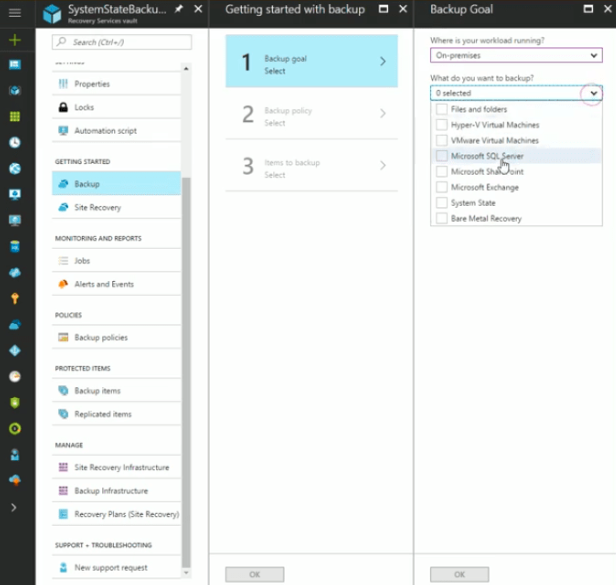
Step 4: Download and Setup Azure Recovery Services Agent
Microsoft Azure Recovery Services (MARS) agent also referred as Azure backup agent is used to backup Windows Server data to Azure. MARS agent can be installed on physical/virtual Windows machine.
Once the MARS agent installation is complete, download vault credential file to register your Windows Server with RSV.
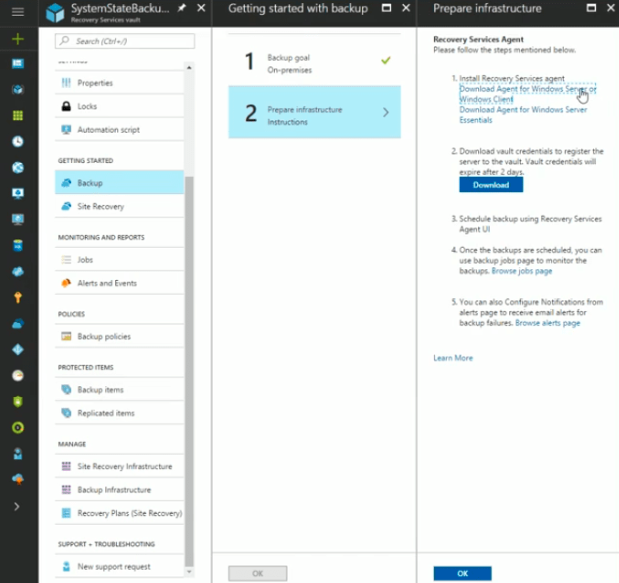
Step 5: Configure Backup for Windows Server
On the Azure backup management console, Click on Schedule Backup option
Now select the files/folders and System State that you want to backup
Specify the Backup Schedule and select the Retention Policy for your backup jobs
Review all the configurations and Click Finish
Now the backup data will be securely transferred and stored on the Recovery Service Vault created from Azure Portal.
Steps to Recover the Backup Data from Azure
Azure Backup allows granular recovery of files/folders. Even if the file is accidentally deleted from the system it can be quickly recovered from Azure using the MARS agent.
Step 1: Open Microsoft Azure backup wizard and Initiate Recovery
Microsoft Azure Backup is installed along with MARS agent. Open Microsoft Azure backup wizard and Choose Recover Data option.
Then, Click on Recover data option – It will open a wizard Getting Started with two options: This server and Another server. This is to identify the origination of backup data.
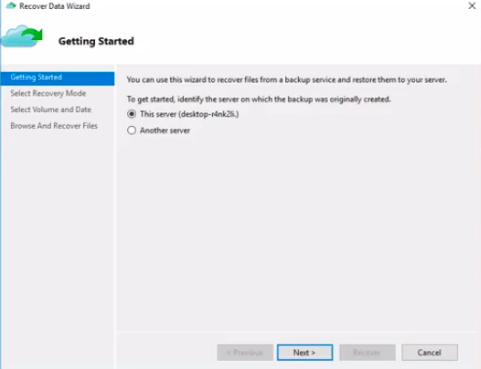
Step 2: Select Recovery mode and Recovery point
To restore data at the individual file level, select Individual files and folders in the recovery mode or to restore at volume level select Volume
Then, Select Volume and date wizard lets you choose the restore location and restore point to mount the data you want to restore
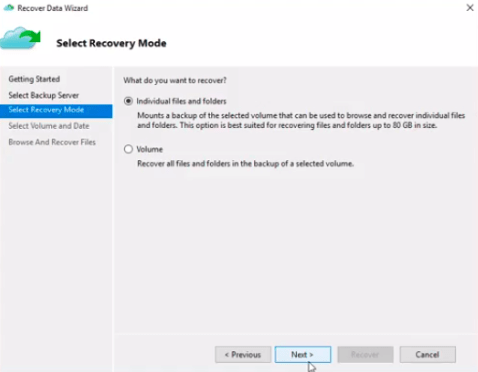
Step 3: Restore the selected items
Then, Browse and Recover files wizard opens. Now copy the data(files/folders) and paste in the restore location to complete the recovery process.
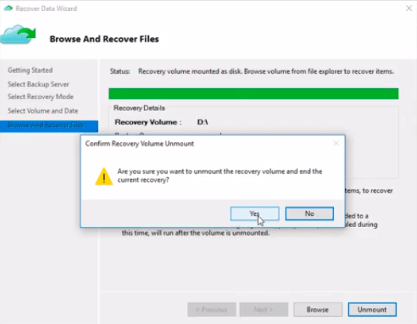
Once the restore is complete, the volume that is accessed during restoration is unmounted.
Thoughts
Hope this article brought a clear view of Windows Server Backup to Azure. Thus, adopting the best cloud technology will let you create an efficient IT infrastructure, along with an effective Disaster Recovery plan. It will also add value to your business by increasing the Flexibility, Security, and Productivity of your organization. Hence, do your research and make the right decision while hiring cloud services to enhance your business.
Experience modern data protection with this latest Vembu BDR Suite v.3.9.0 FREE edition. Try the 30 days free trial here: https://www.bdrsuite.com/vembu-bdr-suite-download/
Follow our Twitter and Facebook feeds for new releases, updates, insightful posts and more.

